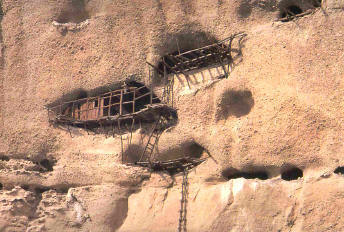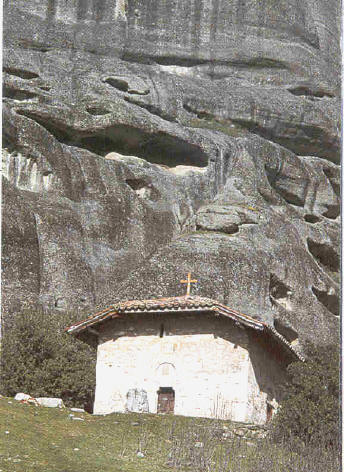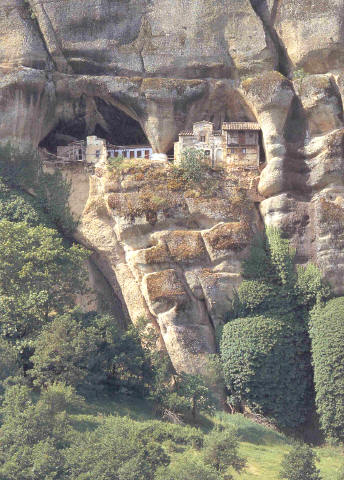In
Meteora, the appearance of monasticism is not accurately determined.
Yet, in the 11th century the askites (hermit monks) designated the
Meteora rocks as a place to live and pray. They hid in the crevices and
the caves to spend the years that would follow, struggling with themselves, the years of their painful ascent through
the heavenly path silently and agonizingly. Up there, lashed by the
rain, unprotected by the cold and the snow, being at the mercy of nature
but always under the roof of the Holy Providence, the hermits lived by
themselves, glorifying God.
struggling with themselves, the years of their painful ascent through
the heavenly path silently and agonizingly. Up there, lashed by the
rain, unprotected by the cold and the snow, being at the mercy of nature
but always under the roof of the Holy Providence, the hermits lived by
themselves, glorifying God.
The following
remains of the Monasteries-Hermitages (-tranquil places where the
hermits live in absolute solitude) remind us of the magnitude of the
offer of the first ascetics and their holy tradition and
-
The Holy Skete
of Panagia Doupiani.
-
The Holy
Monastery of Ypapanti.
-
he Holy
Monastery of St George Mandilas.
-
The Monastery of
Holy Trinity.
-
The Holy
Monastery of Ipsilotera (or The Holy Monastery of Kalligrafon
-
The Holy
Monastery of St Nikolas Bantovas (Kofinas). 
-
The Hermitage of
St Gregory Theologos.
-
The Holy Skete
of St Antony.
-
The Holy
Monastery of Timios Prodromos.
After carrying out
a considerable amount of research, we gathered some evidence concerning
the Holy Monasteries of Panagia Doupiani, The Holy Monastery of Ypapanti,
the Holy Monastery of St George Mandilas and the Holy Monastery of
Ipsilotera (Kalligrafon).
The first monastic
community with a rudimentary organization was the Holy Skete of Doupiani
or of the Stagon which was founded by the monk Nilos. The church is
located just below the Monastery of St. Nicholas Anapafsas.
The monks, who
lived isolated in the surrounding rocks during the week and prayed and
stayed asleep, all by themselves, started gathering on Sundays to attend
Service and worship God, at the Church of Doupiani. This church is the
only building that has been kept alive today. However, it is alleged to
be the touchwood for the materialization of monasticism in Meteora.
The safety and the
isolation brought a great number of monks to the rocks, so over the
centuries 24 monasteries were established in this region, reaching full
peak.

A good deal of
these Monasteries got deserted and died away. Some old rescued
manuscripts are left to remind us of their existence.
The Monastery of
Ipapanti, which is currently uninhabited, belongs to the Monastery of
the Great Meteoron. The monk Nilos, in the year 1367 AD, and the monk
Cyprianus are the founders and proprietors of the monastery. Today, only
the recently restored church has been rescued from destruction.
The Monastery of
St. George Mandilas is situated next to the very last houses of the
village Kastraki on the rock of the Holy Spirit, at a height of 30m
above the ground. It is called Mandilas because during his name day,
young people climb to the cave using ropes and change their
handkerchiefs with new ones they carry with them. They keep the old ones
as a talisman.
The
Holy Monastery of
Ipsilotera or Kalligrafon was erected in 1347AD atop a rock and nowadays
one can only witness the ruins left. During its prime, there had been a
copying and manuscripts’ calligraphy workshop and this is the reason why
the Monastery is also called Kalligrafon.
Translation by Christine Boutsia
|